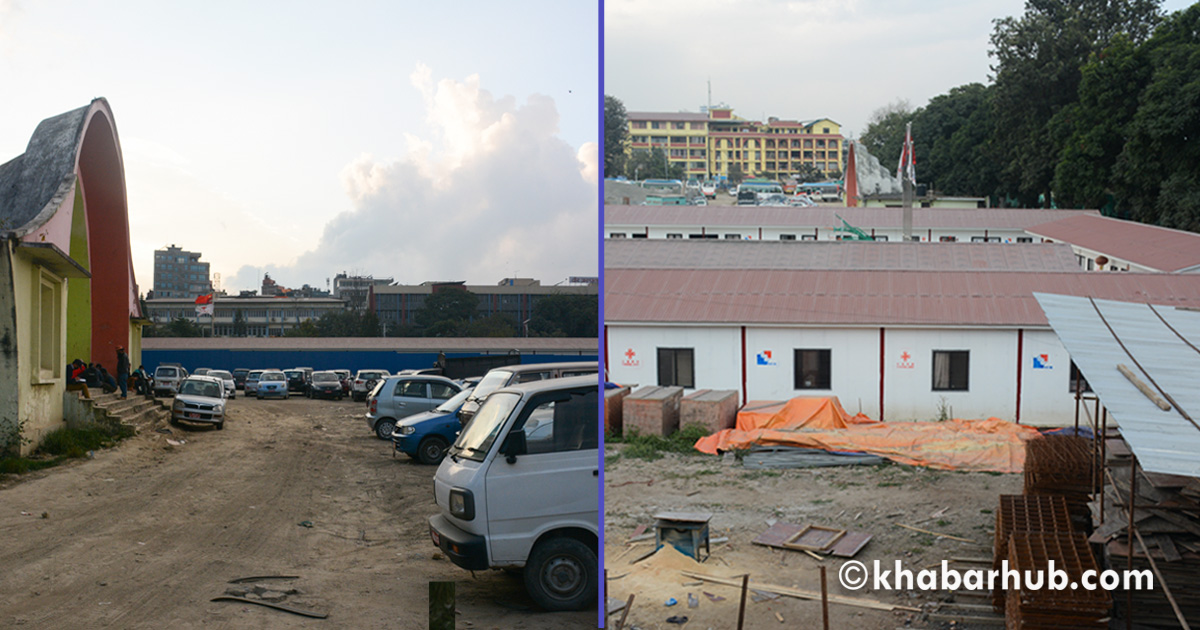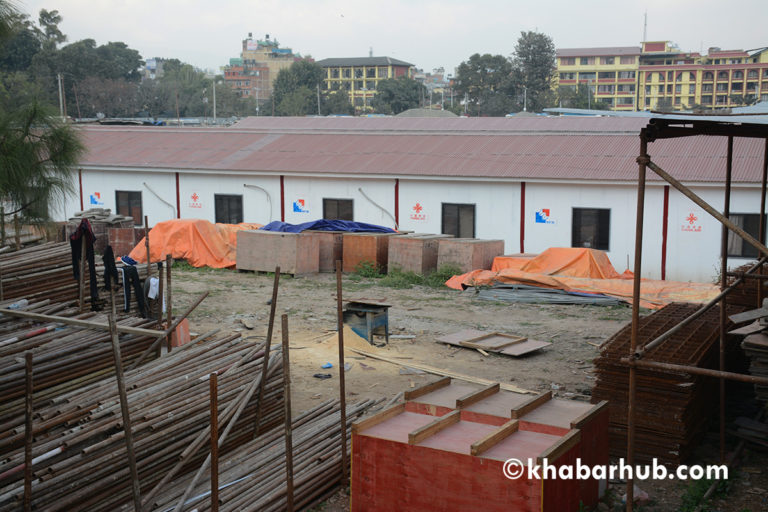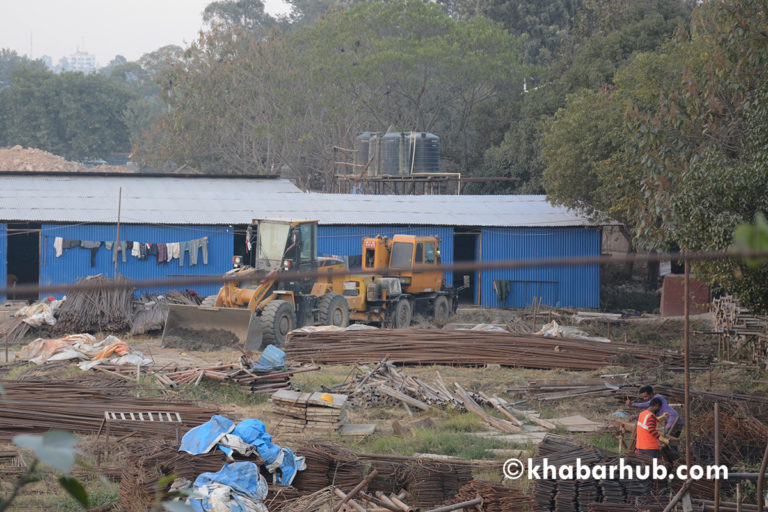0%

KATHMANDU- Population explosion and unplanned construction going on simultaneously is shrinking the open space in the capital. Unsystematic construction work is a common site everywhere and the dwindling open spaces are further declining due to the haphazard piling of the construction materials.
However, the rising awareness of the people is enhancing the clamor for a stop on such activities.
Once a glorious place to gather in, a healthy place to troll around and the place that used to be known as one of the biggest open areas in the cities of Asia, Tundikhel now, seems to be approaching towards ‘coma’. “The weeds around the ground, the crooked bumps of soil, the haphazard piling of the construction material, and the litters all around makes one pine for the past,” says RanjanLal Shrestha, a scouter and the inhabitant of MakhanTole, Kathmandu.
The southern part of Tundikhel is fenced. The haphazard piling up of the construction material meant for the reconstruction of Dharahara, together with the noise and air pollution caused by the vehicles to the next end have made the place disgusting.

Khula Manch, the name given to the platform in Tundikhel and meant for public gatherings, conventions and mass assemblies, refers to the open area with a platform where people can express their opinions openly.
Now, the same Khula Manch is shrunk due to the bus park shifted to the place and the marketplaces constructed with a business motive.
The inner part of Khula Manch is enclosed with big zinc sheets preventing the suffocating passersby from peeping to the once open space. As the crooked eye of the land-mafia, has fallen on it, the public has realized it’s high time for them to protest for the safeguard of it.
What was it like before?
As mentioned by Henry Ambrose Oldfield, British resident surgeon in Kathmandu, in his 1850s book Sketches of NepalTundikhel originally spread from where Rani Pokhari is today in the north to where the Dasarath Stadium is in the south. He assessed it measured two-three miles in length and about 300 yards in width, turning it one of Asia’s biggest parade grounds at that time.
Due to its prime location, Tundikhel, in the past, used to be the means to make one’s authority felt. Some historians say that the first formal encroachment started with Pratap Malla’s decision to get Rani Pokhari built to console his queen.
However, others do not want to blame then rulers as they believe the Mallas were very conscious and proud of their glorious architecture, and for themTundikhel was a vast open space maintained by the rulers for social and cultural events, including GhodeJatra celebrations.
Referring to their wiser plans and designs some researchers argue that Tundikhel was an architectural requirement of the Malla era-vast open spaces that were considered essential near any densely populated settlement. As the rest of the Valley expanded to accommodate new, wealthy towns, palaces, and shrines, Tundikhel alone remained open.
The Khari tree (Khari ko bot) with a marble platform around it was the place for the Rana rulers to make all significant announcements.
The announcements like Jung Bahadur summon to the army to challenge King Rajendra 1848, BirShumsher’s proclamation of making himself the Prime Minister 1885, Chandra Sumsher’s announcement regarding the emancipation of slaves in 1924, the Allies’ success against Hitler’s Germany and the celebration at that victory in 1945, etc. were made here.
The place had been a place for massive tented camp after the 1934 earthquake and was also used as the shelter for disaster panicked people in the 2015 earthquake.
Save Tundikhel Campaign
Dreading the crooked intention of land-mafia, the people have taken to the street now. Intensified encroachment of Khulamanch, have brought the locals, save the heritage campaigners to protest against all activities carried out in the Kulamanch vicinity.
The protest that started with the symbolic activities like signing the petition and submitting the memorandum to the concerned authority got momentum with wider public support. 40 Shutters built in the Khulamanch area were demolished on 24 Baishakh.

In the meantime, Amrita Bhattarai, the person assigned to look after the land and property of DuimajuGuthi encroached another part of Khulamanch under the same Guthi’s ownership.
Marking the infringement of Duimaju Guthi, formerly having a close nexus with HanumandhokaTaleju Bhawani, the members of Sampada Bachau Abhiyaan staged a sit-in the program.
Owing to the public pressure, GuthiSansthan has declared Duimaju Guthi’s agreement void. However, the place has not been evacuated yet. Now and then, the Khulamanch is intruded turning the once glory into a sore sight.
Campaign: Occupy Tundikhel
Pulling the people’s representative to safeguard the heritage, in collaboration with the locals, campaigners, the political leaders, and civil society members and together with the responsible representatives, Occupy Tundikhel:
A Campaign to Free Tundikhel from Intrusion is going to be launched from Nov. 9, 2019, the World Freedom Day.
As the impingement of Tundikhel is continues despite the elected representatives’ presence on various levels, we smelt foul and decided to make them the witness of the people’s will and attempt to obstruct and dismantle such activities, said one of the organizers making herself anonymous.
Organizers expect massive participation of the locals, politicians, the MPs, and the civil society members. The organizer has appealed to the schools, colleges, and other organizations to be part of the campaign and help them demand substantive actions against encroachment.
“The rally which shall include the cultural shows shall form a human-chain to encircleTundikhel for half an hour,” reported Bijaya Shrestha.
Adding that the campaign shall be instinctive in making people come for the protection of open spaces everyone requires in their locality all over the country, Shrestha defended the campaign as an apolitical movement launched by the civilians.
In the campaign to be launched on Saturday for three months, programs demonstrating various arts, cultural programs, photo exhibitions, poetry-related with Khulamanch will be the tools for sensitizing the issue.